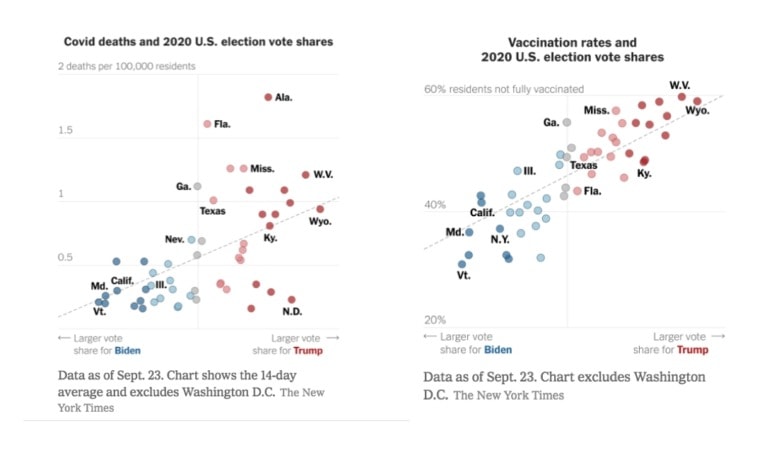
During the early months of Covid-19 vaccinations, several major demographic groups lagged in receiving shots, including Black Americans, Latino Americans and Republican voters.
More recently, the racial gaps — while still existing — have narrowed. The partisan gap, however, continues to be enormous. A Pew Research Center poll last month found that 86 percent of Democratic voters had received at least one shot, compared with 60 percent of Republican voters.
The political divide over vaccinations is so large that almost every reliably blue state now has a higher vaccination rate than almost every reliably red state.
Because the vaccines are so effective at preventing serious illness, Covid deaths are also showing a partisan pattern. Covid is still a national crisis, but the worst forms of it are increasingly concentrated in red America.
As is often the case, state-by-state numbers can understate the true pattern, because every state has both liberal and conservative areas. When you look at the county level, the gap can look even starker.
Below is a set of charts, created by my colleague Ashley Wu, that offers […]











I could not even read the entire article without signing up for the paper! That upset me.
It’s free
Don’t forget that if you had 1 shot and get the virus, you are counted as unvaccinated….which really skews the real numbers. There should be a separate accounting and disclosure of this.
That is not correct Wilma. Here is what the CDC says:
Vaccination status was determined using data from the Kentucky Immunization Registry (KYIR). Case-patients and controls were matched to the KYIR database using first name, last name, and date of birth. Case-patients were considered fully vaccinated if a single dose of Janssen (Johnson & Johnson) or a second dose of an mRNA vaccine (Pfizer-BioNTech or Moderna) was received ≥14 days before the reinfection date. For controls, the same definition was applied, using the reinfection date of the matched case-patient. Partial vaccination was defined as receipt of ≥1 dose of vaccine, but either the vaccination series was not completed or the final dose was received <14 days before the case-patient’s reinfection date. Using conditional logistic regression, ORs and CIs were used to compare no vaccination and partial vaccination with full vaccination among case-patients and controls. SAS (version 9.4; SAS Institute) was used for matching and statistical analyses. This activity was reviewed by CDC and was conducted consistent with applicable federal law and CDC policy.¶
The lack of a significant association with partial versus full vaccination should be interpreted with caution given the small numbers of partially vaccinated persons included in the analysis (6.9% of case-patients and 7.9% of controls), which limited statistical power. The lower odds of reinfection among the partially vaccinated group compared with the unvaccinated group is suggestive of a protective effect and consistent with findings from previous studies indicating higher titers after the first mRNA vaccine dose in persons who were previously infected (7,8).
https://www.cdc.gov/mmwr/volumes/70/wr/mm7032e1.htm
Thank you Stephan Schwartz.